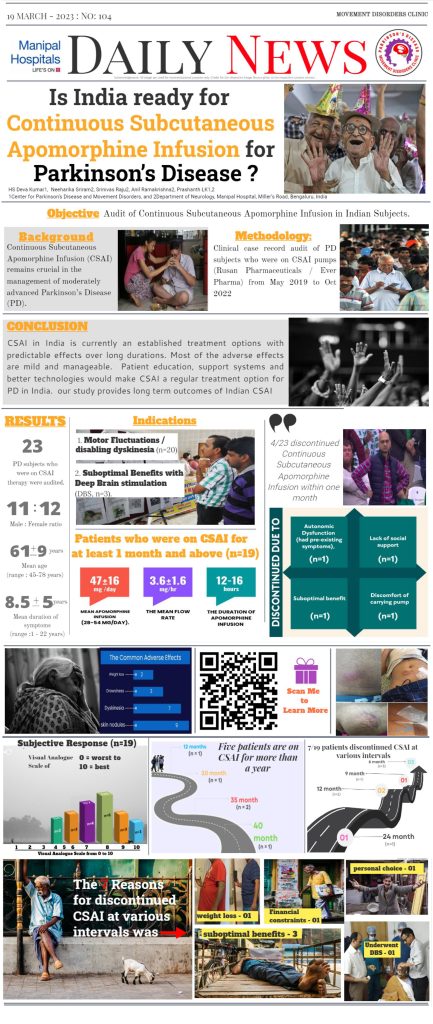Is India ready for Continuous Subcutaneous Apomorphine Infusion for Parkinson’s Disease
Is India ready for Continuous Subcutaneous Apomorphine Infusion for Parkinson’s Disease
HS Deva Kumar1, Neeharika Sriram2, Srinivas Raju2, Anil Ramakrishna2, Prashanth LK1,2
1Center for Parkinson’s Disease and Movement Disorders, and 2Department of Neurology, Manipal Hospital, Miller’s Road, Bengaluru, India
Background: Continuous Subcutaneous Apomorphine Infusion (CSAI) remains crucial in the management of moderately advanced Parkinson’s Disease (PD).
Objective: Audit of CSAI in Indian subjects.
Methodology: Clinical audit of case records of PD subjects with motor fluctuations who were initiated on CSAI pumps (Rusan Pharmaceuticals / Ever Pharma)
Results: Twenty three PD subjects (M:F- 11:12) who were on CSAI therapy were audited. The mean age was 61 ± 9 years (range : 45-78 years) and the mean duration of symptoms was 8.5 ± 5 years (range :1 – 22). The indications were motor fluctuations / disabling dyskinesia (n=20) and suboptimal benefits with Deep Brain stimulation (DBS, n=3). 4/23 discontinued CSAI within one month due to autonomic dysfunction (n=1, had pre-existing symptoms), lack of social support (n=1), suboptimal benefit (n=1) and discomfort of carrying pump (n=1). Patients who were on CSAI for at least 1 month and above (n=19), the mean apomorphine infusion was 47±16 mg /day (28-54 mg/day). The mean flow rate was 3.6±1.6 mg/hr. The duration of apomorphine infusion varied from 12 to 16 hours. There was considerable improvement in the ON periods with reduction in motor fluctuations. The subjective improvement on visual analog scale of 0 (No benefit) to 10 (Best benefit), the average score was 6.7 (range : 4-10). The common adverse effects noted included skin nodules(n=9), drowsiness(n=3), weight loss(n=2), and variable dyskinesias(n=7). Five patients are on CSAI for more than a year (12 months, 20 months, 35 months (n=2), and 40 months). 7/19 patients discontinued CSAI at various intervals (3 at 6 months, 1 at 9 months, 2 at 1 year, and 1 at 2 years) for varied reasons (weight loss -1, suboptimal benefits -3, financial constraints -1, personal choice -1, underwent DBS-1).Conclusion: CSAI in India is currently an established treatment options with predictable effects over long durations. Most of the adverse effects are mild and manageable. Patient education, support systems and better technologies would make CSAI a regular treatment option for PD in India.

